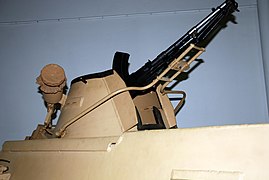Humber Light Reconnaissance Car
A request that this article title be changed to Humber light reconnaissance car is under discussion. Please do not move this article until the discussion is closed. |
This article needs additional citations for verification. (May 2017) |
| Humber Light Reconnaissance Car | |
|---|---|
 Humber LRC Mk III | |
| Place of origin | United Kingdom |
| Production history | |
| Manufacturer | Humber (Rootes Group) |
| Produced | 1940–1943 |
| No. built | more than 2,400[1] |
| Specifications (Mark II) | |
| Mass | 3.17 tons |
| Length | 14 ft 4 in (4.37 m) |
| Width | 6 ft 2 in (1.88 m) |
| Height | 6 ft 11 in (2.11 m) |
| Crew | 3 |
| Armour | up to 12 mm |
Main armament | Boys anti-tank rifle |
Secondary armament |
|
| Engine | 4.1 L 6-cylinder inline sidevalve petrol engine 80–87 hp (60–65 kW) |
| Power/weight | 29 hp/tonne |
| Drive | 4 x 2 wheel |
Operational range | 110 mi (180 km) |
| Maximum speed | 75 mph (121 km/h) on road |
The Humber Light Reconnaissance Car, also known as Humberette or Ironside, was a British armoured car produced during the Second World War.
Design
[edit]Produced by the Rootes Group, the Humber Light Reconnaissance Car was an armoured car based on the Humber Super Snipe chassis (as was the Humber heavy utility car).[2][3] It was equipped with a No. 19 radio set. From 1940 to 1943 over 3600 units were built.
Operational history
[edit]The vehicle was used by Infantry Reconnaissance Regiments and the RAF Regiment in Tunisia, Italy and Western Europe. After the war, some vehicles remained in service with the British units in India and in the Far East. The LRC was used widely by the Reconnaissance Corps and was also used by the Reconnaissance squadron of the 1st Czechoslovak Independent Armoured Brigade Group.[4]
Three Mk I vehicles were modified for use by the British Royal Family and the Cabinet ministers and were known as "Special Ironside Saloons".
Variants
[edit]
- Mk I
The original version with open-topped hull and 4×2 drive. Armoured to a maximum of 10 mm on the front and 7–9 mm on the sides.[5] Armament was a Boys anti-tank rifle and a Bren light machine gun. Only a limited number were built before the Mk I was replaced by the Mk II.[6]
- Mk II
The Mk II had an enclosed roof with a turret for the machine gun and retained the 4×2 drive of the Mk I. The Boys faced forward in the front of the hull. Otherwise armoured as the Mark I, the roof was 7 mm and the turret 6 mm.[5][7]

- Mk III (1941)
The Mk III was externally similar to the Mk II but had 4×4 drive. Production began in late 1941.[8]
- Mk IIIA (1943)
The only difference from the Mk III was additional vision ports at the front angles of the hull.[8] Armour was 12 mm to the front, 8 mm to the sides, 7 on the roof and rear, and 6 mm on the turret.[5]
- Ironside Special Saloon
Built for VIP use, Thrupp & Maberly provided a relatively luxurious interior which was split by a Perspex screen to separate driver and passengers. A passenger side door was provided to make entrance and exit easier and the driver had a side hatch,[9] the two-part screen running in tracks fitted to the front seats: sliding both portions to the driver's (right) side allowed the front passenger (left) seat back to be folded for an easier exit. Two Ironside 'specials' of this kind were used by cabinet ministers and members of the royal family, while six minus the privacy screen were used as armoured staff cars.
In all 3,600 Humber Light Reconnaissance Cars were built (including the 200 Ironside Is) and the MkIII and MkIIIA were the cars most widely used by the Reconnaissance Corps in action, and many were also employed overseas by the RAF Regiment for airfield defence.
Surviving vehicles
[edit]-
RAF Museum MkIIIA
-
Turret detail RAF Museum MkIIIA
A number of vehicles are preserved in museums:
- Dutch Cavalry Museum
- Royal Museum of the Armed Forces and of Military History, Brussels, Belgium
- Royal Air Force Museum London has a Mk IIIA
- National War and Resistance Museum, Overloon has a restored Mk III.
- Military College of EME, Trimulgherry has an LRC as a gate guardian
- 43rd Reconnaissance Regiment Living History Group (UK) operate a replica vehicle based on an LRC MK IIIa chassis.
A reproduction also exists in private ownership in the Czech Republic[10]
A replica built on a postal jeep chassis and with wooden armour exists in Florida, where it is primarily used for re-enacting.
See also
[edit]Notes
[edit]- ^ Doherty p 20
- ^ Fletcher, David (1989). The Great Tank Scandal: British Armour in the Second World War - Part 1. HMSO. p. 35. ISBN 978-0-11-290460-1.
- ^ Doherty (2011), p6
- ^ Richard Doherty, New Vanguard 77: Humber Light Reconnaissance Car 1941–45, Osprey Publishing 2011, ISBN 978-1-84908-310-2
- ^ a b c Doherty p9
- ^ War Wheels: Humber LRC I
- ^ War Wheels: Humber LRC II
- ^ a b War Wheels: Humber LRC III
- ^ "Protection Detail". www.keymilitary.com. 15 October 2020. Retrieved 20 July 2023.
- ^ "Humber light reconnaissance cars and scout cars" (PDF), Surviving Panzers website, 14 January 2022
References
[edit]- George Forty - World War Two Armoured Fighting Vehicles and Self-Propelled Artillery, Osprey Publishing 1996, ISBN 978-1-85532-582-1.
- I. Moschanskiy - Armored vehicles of the Great Britain 1939-1945 part 2, Modelist-Konstruktor, Bronekollektsiya 1999-02 (И. Мощанский - Бронетанковая техника Великобритании 1939-1945 часть 2, Моделист-Конструктор, Бронеколлекция 1999-02).
- Doherty, R Morshead, H (illustrator) Humber Light Reconnaissance Car 1941–45 New Vanguard 177 (2011) Osprey Publishing 9781849083102


